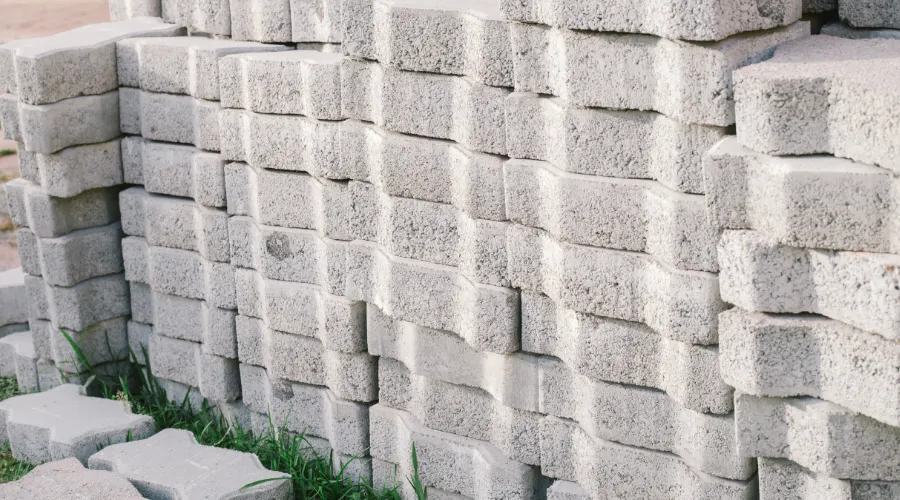Concrete bricks are one of the widely popular and highly used building materials. Their physical properties and versatile uses make people choose concrete bricks over other brick types. Although they are widely used, there is still limited awareness among the people. Here, we break the stereotype, as this blog clearly explains what concrete bricks are, why they are widely preferred, their applications, advantages, disadvantages, and more.
What is a Concrete Brick?
A concrete brick is a pre-casted cement brick made with a mixture of cement, sand, and fine aggregates. These laboratory-made bricks are produced under constant supervision to enhance their unique properties to stand out from other brick properties in the market.

Types of Concrete Brick
Concrete bricks are generally classified into four types based on their weight, shape, and the aggregates used. The following are the types of concrete bricks:
- Solid Cement bricks
- Hollow Cement bricks
- Fly Ash Bricks
- Interlocking Bricks
Solid Cement Bricks
These bricks are dense, heavy, and uniform in structure, and they have high durability and strength. Solid Cement Bricks are used for the construction of foundation walls, columns, and other load-bearing structures.
Hollow Cement Bricks
Hollow cement bricks are lightweight and are designed with voids in the middle to reduce the overall weight. These bricks improve thermal insulation and have numerous advantages in terms of cost and production. They are generally used for the construction of non-load-bearing structures, such as partition walls and infilling panels, considering their lightweight nature.
Fly Ash Bricks
These are made from a mixture of cement and fly ash(extracts of coal). They are sustainable and eco-friendly bricks, using fly ash as the main aggregate. Fly ash bricks are lightweight, can withstand high temperatures and are even resistant to fire.
These bricks are commonly used in both residential and commercial projects. For example, these bricks are used as partition walls and in other non-load-bearing structures.
Interlocking Bricks
Interlocking bricks are a special type of brick that comes in different shapes and sizes. These bricks are designed to interlock bricks together, reducing the need of mortar and other adhesive pastes. These bricks are custom-made bricks that are manufactured based on the needs and requirements of the building.
Properties of Concrete Brick
- Density & colour: The thickness of concrete bricks ranges from 300-1800 kg/m³ based on the source material, and they come in different colours.
- Heat Resistance: They have lower density, which helps to protect the building from fire and hot weather conditions.
- Strength: They have a high load-bearing capacity and can be used in engineered and mechanical structures.
- Durability: They are resistant to high wear and tear and have longevity.
Raw Materials Required for Manufacturing
The raw materials required for the manufacturing of concrete bricks include Portland Cement, Water, Sand, and Gravel. In certain cases, fly ash and other additives are included as fine aggregates. Since concrete bricks are produced in various shapes and sizes, their colour pigments and additives may vary.
Manufacturing Process of Concrete Bricks
Preparation of Raw Materials
The raw materials such as cement, sand, aggregates, and additional fillers are chosen based on quality. The selected materials are tested in the laboratory for required standards and adequate proportions of the ingredients are determined.
Mixing and Blending
The cement, sand, and aggregates are mixed using mechanical mixers, adding water until they achieve a uniform and homogeneous mixture. An adequate proportion of additives (fly ash or other pigments) is blended to achieve the desired properties.
Molding
The cement mortar is poured into the molds of required shapes and sizes. Vibrators are used to eliminate pore gaps, and ahydraulic press compresses the mixture into a molded brick. The mortar is maintained in the mold throughout the drying and curing process for days until the bricks are completely solidified.
Curing & Drying
After molding, the concrete bricks are cured using water, air, or stream in a controlled environment to improve hydration and strength. The cured bricks are then removed from the molds and dried to remove excessive moisture content.
Quality Checks
Inspections are conducted throughout the manufacturing process from start to finish. Many quality checks are performed in the laboratory at different stages to check the quality of the bricks.
Pros & Cons of Using Concrete Bricks
Pros
- Highly durable and can withstand harsh weather conditions.
- Used in nearly every construction process.
- Available in various sizes, shapes, and designs.
- High thermal resistance and fireproof.
- Easily available and cost-effective.
Cons
- Solid blocks are heavy and require careful handling.
- Higher water absorption rate, causing efflorescence and moisture damage.
- Adds more loads to structures and could get cracked under excessive loads.
- Consumption of natural resources and high energy usage in manufacturing.
- Requires periodic maintenance for longevity.
Comparison between Concrete Bricks & Clay Bricks
| Aspect | Concrete Bricks | Clay Bricks |
| Raw materials used | Cement, Sand, Aggregate (limestone), and additives. | Surface clays, shales, sand, and fire clays. |
| Initial reaction | Shrinks due to loss of moisture | Expands due to the addition of moisture |
| Weight | Solid cement blocks weigh more than clay bricks. | Clay bricks are less weight compared to cement bricks. |
| Strength | Gains strength over time. | Loses strength over time. |
| Compressive strength | High compressive strength | Comparatively low compressive strength |
Conclusion
Concrete bricks are one of the necessary building materials in the modern construction field. They are better known for their strength, durability, and versatile uses in both residential and commercial projects. These concrete bricks are at the forefront of modern construction and their continuous evolution makes them easy and reliable choice. It would be no surprising if the concrete bricks completely replaced the clay bricks in the future.

